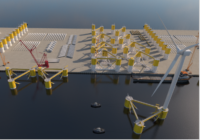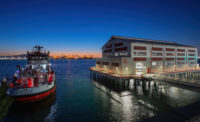A project to build a 400-acre offshore wind turbine assembly terminal at California’s Port of Long Beach is expected to cost $4.7 billion, port officials say.
The port released a concept report May 9 further outlining its proposal for the facility it says would be the largest of its kind in the U.S. specifically designed for offshore wind turbines. Port officials hope to start construction as early as January 2027 for the proposed Pier Wind project. Under that timeline, the first 100 acres could open for operations in early 2031 and the whole facility could be open in 2035.
“As society transitions to clean energy, our harbor is ideally located for such an enterprise—with calm seas behind a federal breakwater, one of the deepest and widest channels in the U.S., direct access to the open ocean and no air height restrictions,” said Mario Cordero, the port’s executive director, in a statement. “No other location has the space to achieve the economies of scale needed to drive down the cost of energy for these huge turbines.”
Port officials say they will seek state and federal funding for the project.
Pier Wind would consist of built land, 7,500 ft long and 2,350 ft wide, capable of handling heavy-lift cranes and large wind turbine components. It would be connected to ground transportation via a 250-ft-wide corridor with two rail lines and four lanes for vehicle traffic, including a pair of bridges, each between 700-850 ft long.
According to the concept report, prepared by Port of Long Beach consultant Moffat & Nichol, project cost could reach $7 billion, with uncertain global economics factored in.
The report details the proposed “aggressive” schedule, which would break construction into two phases. The first would include the transportation corridor, bridges, first 200 acres of terminal, 3,750 ft of wharf, sinking basin, tug dock and wet storage piers. Phase 2 would include the remaining 200 acres of terminal and 3,750 ft of wharf. Dredging operations would be conducted 24/7 with three hydraulic and three mechanical dredges.
As ENR previously reported, the aim behind the Pier Wind proposal is to support the California Energy Commission’s goal of producing 25 GW of offshore wind energy capacity by 2045.
Last December, the first West Coast offshore wind lease auction drew offers totaling more than $757 million for five tracts. On May 10, the commission adopted a report outlining an environmental review and permitting process for offshore wind projects in the state.
The proposed site is located off the main ship channel in the port’s outer harbor, between the Navy Mole from a former shipyard and the federal breakwater. The port is also planning another project that would deepen the entrance of the main channel and widen portions of the channel.
The location south of the Long Beach International Gateway Bridge means there would be no height restrictions, so 1,100-ft-tall turbines could be assembled at the facility and then towed to future offshore wind farms.
Sharon Weissman, president of the Long Beach Harbor Commission, said in a statement that offshore wind power “is essential” for the port’s own zero-emissions goals. As ENR previously reported, the port is planning to convert heavy trucks from diesel to electric and expand its rail infrastructure.
“Building Pier Wind lays the foundation for a zero carbon energy future, not only for the public but for our operations as well,” Weissman said.






Post a comment to this article
Report Abusive Comment